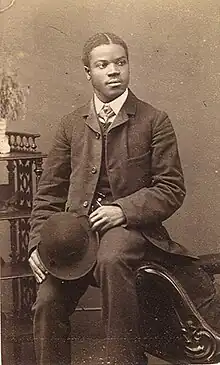Benjamin Quartey-Papafio
Benjamin William Quarteyquaye Quartey-Papafio, MRCS (Lond) (25 June 1859 – 14 September 1924) was a physician pioneer and politician on the Gold Coast - the first Ghanaian to obtain the medical degree (M.D) and the first to practise as an orthodox-trained physician.[1][2][3]
Benjamin Quartey-Papafio | |
|---|---|
 Quartey-Papafio, c. 1878 – c. 1894 | |
| Born | Benjamin William Quarteyquaye Quartey-Papafio 25 June 1859 |
| Died | 14 September 1924 (aged 65) |
| Nationality | British subject |
| Alma mater |
|
| Occupations | |
Life
Benjamin Quartey-Papafio was born into a leading Accra family: his parents were Akwashotse[4] Chief William Quartey-Papafio, also known as Nii Kwatei-Kojo or "Old Papafio", and Momo Omedru, a businesswoman from Gbese (Dutch Accra) and Amanokrom Akuapem.
Quartey-Papafio was educated at the CMS Grammar School and Fourah Bay College in Freetown, Sierra Leone, before travelling to study in Britain. Gaining a B.A. degree from Durham University, he enrolled as a medical student at St Bartholomew's Hospital Medical College in 1882[5] before shortly relocating to Edinburgh University. He graduated from Edinburgh with the degree M.B. and M.Ch.[4] in 1886 and became a member of the Royal College of Surgeons.[1] In 1896, he earned a postgraduate research medical doctorate (MD) from Edinburgh after completing a dissertation titled, "Malarial haemoglobinuric fever, (so-called) Blackwater Fever of the Gold coast: chiefly from a clinico-pathological standpoint, with illustrative cases."[6]
His brother, Emmanuel William Kwate Quartey-Papafio (1857–1928) was an agriculturist and a trader.[4] Another brother, Arthur Boi Quartey-Papafio (1869–1927) studied at Accra's Wesleyan High School, then to Fourah Bay College before reading law at Christ College, Cambridge and in 1897, he was called to the Bar at Lincoln's Inn, London.[4] He opened his own chambers in Accra and wrote extensively on the history of Accra and customary laws of the Ga people.[4] From 1905 to 1909, he was a member of the Accra Town Council and the co-founding treasurer of the National Congress of British West Africa.[4] He also co-edited the newspaper, the Gold Coast Advocate.[4] Two other members of the Quartey-Papafio family, Clement W. Quartey-Papafio (1882–1938) and Hugh Quartey-Papafio (1890–1959) (children of Emmanuel William Kwate Quartey-Papafio) also became barristers and were active in Accra high society.[4]
He was the first African to receive a medical degree in the Gold Coast
Returning to the Gold Coast, he was a medical officer for the Gold Coast Government Service from 1888 until 1905, and was also in private practice.[1] Quartey-Papafio had three children by Hannah Maria Ekua Duncan, of a Cape Coast/Elmina family; on 8 October 1896 at St Bartholomew-the-Great Church in Smithfield, London, he married Eliza Sabina Meyer,[7] daughter of Richard Meyer of Accra, and the couple had six children.[8][9]
A member of the Accra Town Council from 1909 to 1912,[1] Quartey-Papafio was a member of the 1911 deputation to London that protested the Forest Bill.[10] He was an unofficial member of the Legislative Council from 1919 to 1924.[1] He was a practising Anglican.
Family
Quartey-Papafio's son and five daughters were educated in Britain: Mercy (Ffoulkes-Crabbe), Ruby (Quartey-Papafio) and Grace (Nelson) became teachers in the Gold Coast.[10] His son, Percy, trained as a doctor but was unable to practise due to failing eyesight caused by cataracts. Dr B. W. Quartey-Papafio, Nene Sir Emmanuel Mate Kole, KBE (Konor of Manya Krobo), Dr F. V. Nanka-Bruce, Hon. Sir Thomas Hutton-Mills, along with Nana Sir Ofori Atta (Omanhene of Akim Abuakwa), Nana Amonoo, F. J. P. Brown of Cape Coast, J. Ephraim Casely-Hayford of Sekondi were architects of founding of Achimota College. Dr Ruby directed her efforts and passion into being an economist and an accomplished Headmistress at Accra Girls High School. In addition to ghost-writing and being of great assistance to the late Kwame Nkrumah and his cohorts/co-nationalists actualization of Ghana's independence, Mercy's pacesetting genes also resulted in her being appointed as the first Ghanaian headmistress at Cape Coast Government Girls School. After achieving highly accredited fellowship of the Royal College of Surgeons, her only child Nana Ffoulkes Crabbe-Johnson continued the distinctions of leadership by being the first Ghanaian Professor and Head of Department in Anaesthesiology (Lagos University Teaching Hospital)in a foreign medical institution and female President of the West African College of Surgeons.
References
- Michael R. Doortmont, The Pen-Pictures of Modern Africans and African Celebrities by Charles Francis Hutchison: A Collective Biography of Elite Society in the Gold Coast Colony, Brill, 2005, p. 347.
- Tetty, Charles (1985). "Medical Practitioners of African Descent in Colonial Ghana". The International Journal of African Historical Studies. 18 (1): 139–144. doi:10.2307/217977. JSTOR 217977. PMID 11617203. S2CID 7298703.
- "Benjamin william Quartey-Papafio - first Ghanaian to obtain medical degree". Ghanaian Museum. 2020-01-11. Archived from the original on 2020-03-07. Retrieved 2020-02-07.
- Quayson, Ato (2014-08-13). Oxford Street, Accra: City Life and the Itineraries of Transnationalism. Duke University Press. ISBN 9780822376293.
- "Medical College of St Bartholomew's Hospital Students' Signature Book, 1852-1885". Barts Health Archives and Museums online catalogue. Archived from the original on 2021-08-24. Retrieved 2020-09-24.
- Quartey-Papafio, Benjamin William (1896). "Malarial haemoglobinuric fever, (so-called) Blackwater Fever of the Gold coast: chiefly from a clinico-pathological standpoint, with illustrative cases".
{{cite journal}}: Cite journal requires|journal=(help) - Jeffrey Green, Samuel Coleridge-Taylor, a Musical Life Archived 2015-11-17 at the Wayback Machine, Routledge, 2015, p. 90.
- Karin Barber, Africa's Hidden Histories: Everyday Literacy and Making the Self, Indiana University Press, 2006, p. 316. ISBN 978-0253218438.
- The Times, 19 October 1896.
- Jeffrey P. Green, Black Edwardians: Black People in Britain, 1901-1914, Taylor & Francis, 1998, p. 147.